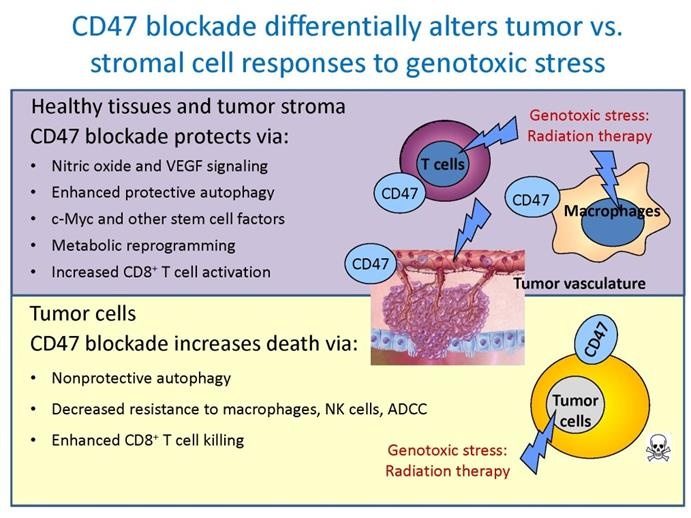Biochemical Pathology
Dr. David Roberts, Head, Biochemical Pathology Section
Building 10, Room 2A27
(301) 594-5256
To learn more, visit Dr. Roberts' CCR Web site.
General Information
Mailing Address:
Biochemical Pathology Section
Laboratory of Pathology, CCR
National Cancer Institute
Building 10, Room 2A33
10 Center Drive
Bethesda, MD 20892-1500
Our Science
The Biochemical Pathology Section is defining functions of the modulatory extracellular matrix protein thrombospondin-1, its receptors, and downstream signal transduction pathways in cancer and in a fungal disease that limits the survival of cancer patients. We have identified important roles for thrombospondin-1 and its cell surface signaling receptor CD47 in regulating tumor angiogenesis, perfusion, antitumor immunity, and responses to stress induced by cytotoxic cancer therapies and fungal infection. Based on these insights, we have developed novel therapeutics targeting CD47 that enhance the efficacy of radiation therapy and immunotherapy in murine cancer models. Through patent licensing and collaborations we are supporting the translation of these discoveries towards clinical applications. The lab is currently pursuing three major projects:
1. Regulation of Vascular Cell Physiology, Tumor Biology, and Stress Responses by Thrombospondin-1 and CD47
Our previous work established that CD47 is the necessary receptor for thrombospondin-1 that mediates its effects on physiological nitric oxide/cGMP signaling and cellular responses to stress. We demonstrated that thrombospondin-1/CD47 signaling has physiological roles in the acute control of blood flow, blood pressure, and platelet hemostasis. These findings have implications for understanding the hypertensive and prothrombotic side effects of therapeutic angiogenesis inhibitors. Based on studies using Thbs1 and Cd47 null mice, we discovered that this pathway limits cell and tissue survival of ischemic injuries and demonstrated that agents blocking thrombospondin-1/CD47 interactions enhance recovery from fixed ischemia and ischemia/reperfusion injuries in mice, rats, and pigs. Remarkably, this therapeutic benefit extends to radiation injuries in soft tissues and bone marrow, but irradiated tumors are not protected. Rather, cytotoxic T cell immunity against irradiated tumors is enhanced when CD47 is suppressed either in the tumor or its host. We identified autophagy as a necessary mediator of the radioprotective response in nonmalignant tissues and demonstrated that CD47 blockade globally modulates metabolism to enhance survival of irradiated cells and mice. We also discovered that CD47 signaling limits self-renewal of nontransformed cells by limiting expression of c-Myc and other stem cell transcription factors. In contrast, a CD47 blocking antibody suppresses stem cell character in triple negative breast cancer cells.
2. Immune Regulation by Thrombospondin-1 and CD47.
Although inhibition of angiogenesis contributes to the tumor suppressive activity of thrombospondin-1, thrombospondin-1 signaling through CD47 is also a potent inhibitor of anti-tumor immunity. CD47 signaling regulates both innate and adaptive immune responses. We previously found that thrombospondin-1 globally suppresses T cell receptor signaling via CD47 and an unknown proteoglycan. We have now identified a proteoglycan isoform of CD47 that mediates this activity. We identified hydrogen sulfide (H2S) as an autocrine mediator of T cell activation and discovered that CD47 signaling inhibits both activation-induced biosynthesis of H2S in T cells and their ability to respond to physiological concentrations of exogenous H2S. We further discovered that CD47 signaling regulates the immunosuppressive activity of VEGF in T cells. These pathways are relevant to anti-tumor immunity because therapeutic blockade of CD47 enhances CD8+ CTL killing of tumor cells in vitro and CD8+ T cell-dependent rejection of irradiated tumors in vivo. This effect depends on CD47 expression in the tumor microenvironment and is, therefore, distinct from the previously reported “don’t eat me” function of CD47 expressed on tumor cells. We have also explored potential effects of CD47-blocking therapies on the susceptibility of cancer patients to disseminated Candida infections by comparing survival and immune responses to the pathogen in wild type versus cd47-null and Thbs1-null mice.
3. Host-pathogen Interactions Mediating Candida albicans Pathogenesis
Candidiasis and candidemia are frequent complications of cancer treatment that result in high morbidity and mortality. Due to emerging resistance to the available antifungal agents, new approaches are needed to prevent and treat these infections in cancer patients. We previously identified specific host factors that regulate the pathogenesis. We also identified C. albicans genes that are induced by these factors when the pathogen enters the host vascular compartment. One of these, HBR1, is essential for vegetative growth and haploinsufficient for suppressing the cellular differentiation required for mating. We examined the function of a nucleotide binding site in Hbr1p and its role in virulence. We also characterized two Candida genes that mediate urea utilization by C. albicans in the host and their roles in virulence. These studies have defined new mechanisms by which C. albicans adapts to the vascular compartment of its host and identified molecular targets required for this adaptation that could be targeted to improve the management of disseminated candidemia.
Useful Links:
American Society for Matrix Biology
